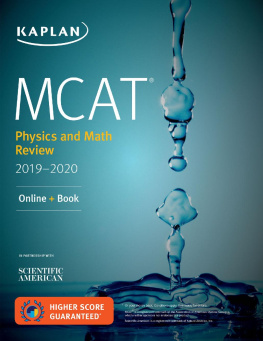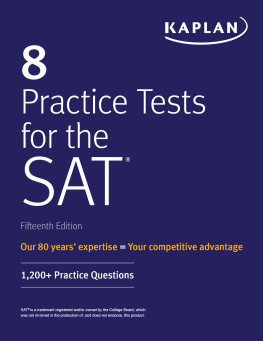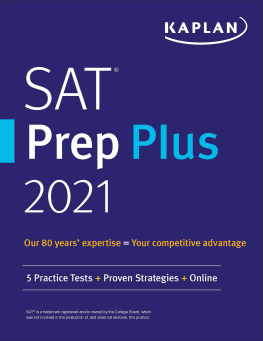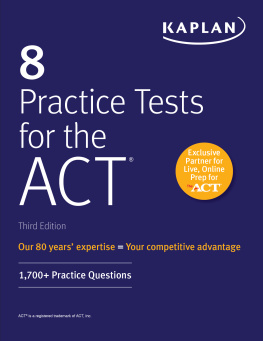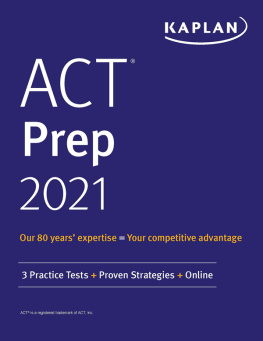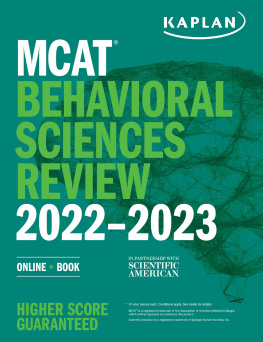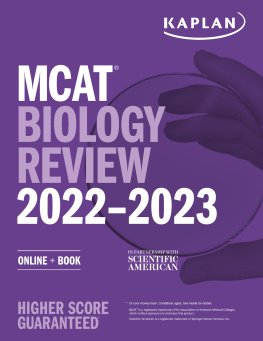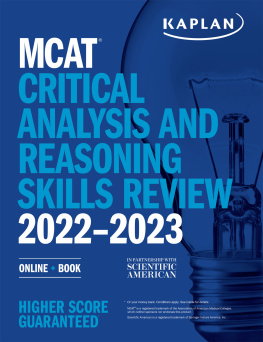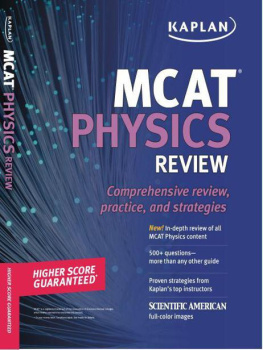
MCAT Physics and Math Review
20192020
Edited by Alexander Stone Macnow, MD
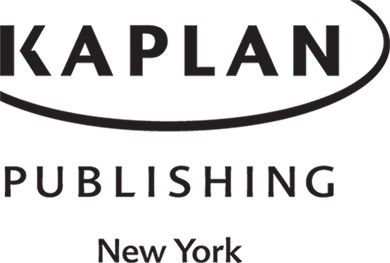
Table of Contents
Guide
MCAT is a registered trademark of the Association of American Medical Colleges, which neither sponsors nor endorses this product.
This publication is designed to provide accurate and authoritative information in regard to the subject matter covered. It is sold with the understanding that the publisher is not engaged in rendering medical, legal, accounting, or other professional services. If legal advice or other expert assistance is required, the services of a competent professional should be sought.
2018 by Kaplan, Inc.
Published by Kaplan Publishing, a division of Kaplan, Inc.
750 Third Avenue
New York, NY 10017
All rights reserved under International and Pan-American Copyright Conventions. By payment of the required fees, you have been granted the non-exclusive, non-transferable right to access and read the text of this eBook on screen. No part of this text may be reproduced, transmitted, downloaded, decompiled, reverse engineered, or stored in or introduced into any information storage and retrieval system, in any form or by any means, whether electronic or mechanical, now known or hereinafter invented, without the express written permission of the publisher.
ISBN: 978-1-5062-3547-9
10 9 8 7 6 5 4 3 2 1
Kaplan Publishing print books are available at special quantity discounts to use for sales promotions, employee premiums, or educational purposes. For more information or to purchase books, please call the Simon & Schuster special sales department at 866-506-1949.
The Kaplan MCAT Review Team
- Alexander Stone Macnow, MD
Editor-in-Chief
- ine Lori, PhD
Editor - Derek Rusnak, MA
Editor - Mikhail Alexeeff
Kaplan MCAT Faculty - Laura L. Ambler
Kaplan MCAT Faculty - Krista L. Buckley, MD
Kaplan MCAT Faculty - Kristen L. Russell, ME
Editor - Pamela Willingham, MSW
Editor - Melinda Contreras, MS
Kaplan MCAT Faculty - Samantha Fallon
Kaplan MCAT Faculty - Jason R. Pfleiger
Kaplan MCAT Faculty
Faculty Reviewers and Editors: Elmar R. Aliyev; James Burns; Jonathan Cornfield; Alisha Maureen Crowley; Brandon Deason, MD; Nikolai Dorofeev, MD; Benjamin Downer, MS; Colin Doyle; Christopher Durland; M. Dominic Eggert; Marilyn Engle; Eleni M. Eren; Raef Ali Fadel; Elizabeth Flagge; Adam Grey; Tyra Hall-Pogar, PhD; Scott Huff; Samer T. Ismail; Ae-Ri Kim, PhD; Elizabeth A. Kudlaty; Kelly Kyker-Snowman, MS; Ningfei Li; John P. Mahon; Matthew A. Meier; Nainika Nanda; Caroline Nkemdilim Opene; Kaitlyn E. Prenger; Uneeb Qureshi; Bela G. Starkman, PhD; Rebecca Stover, MS; Kyle Swerdlow; Michael Paul Tomani, MS; Nicholas M. White; Allison Ann Wilkes, MS; Kerranna Williamson, MBA; and Tony Yu
Thanks to Kim Bowers; Eric Chiu; Tim Eich; Tyler Fara; Owen Farcy; Dan Frey; Robin Garmise; Rita Garthaffner; Joanna Graham; Allison Harm; Beth Hoffberg; Aaron Lemon-Strauss; Keith Lubeley; Diane McGarvey; Petros Minasi; John Polstein; Deeangelee Pooran-Kublall, MD, MPH; Rochelle Rothstein, MD; Larry Rudman; Sylvia Tidwell Scheuring; Carly Schnur; Karin Tucker; Lee Weiss; and the countless others who made this project possible.
About Scientific American
As the worlds premier science and technology magazine, and the oldest continuously published magazine in the United States, Scientific American is committed to bringing the most important developments in modern science, medicine, and technology to our worldwide audience in an understandable, credible, and provocative format.
Founded in 1845 and on the cutting edge ever since, Scientific American boasts over 150 Nobel laureate authors including Albert Einstein, Francis Crick, Stanley Prusiner, and Richard Axel. Scientific American is a forum where scientific theories and discoveries are explained to a broader audience.
Scientific American published its first foreign edition in 1890, and in 1979 was the first Western magazine published in the Peoples Republic of China. Today, Scientific American is published in 14 foreign language editions. Scientific American is also a leading online destination ( www.ScientificAmerican.com ), providing the latest science news and exclusive features to millions of visitors each month.
The knowledge that fills our pages has the power to spark new ideas, paradigms and visions for the future. As science races forward, Scientific American continues to cover the promising strides, inevitable setbacks and challenges, and new medical discoveries as they unfold.
Preface
And now it starts: your long, yet fruitful journey toward wearing a white coat. Proudly wearing that white coat, though, is hopefully only part of your motivation. You are reading this book because you want to be a healer.
If you're serious about going to medical school, then you are likely already familiar with the importance of the MCAT in medical school admissions. While the holistic review process puts additional weight on your experiences, extracurricular activities, and personal attributes, the fact remains: along with your GPA, your MCAT score remains one of the two most important components of your application portfolioat least early in the admissions process. Each additional point you score on the MCAT pushes you in front of thousands of other students and makes you an even more attractive applicant. But the MCAT is not simply an obstacle to overcome; it is an opportunity to show schools that you will be a strong student and a future leader in medicine.
We at Kaplan take our jobs very seriously and aim to help students see success not only on the MCAT, but as future physicians. We work with our learning science experts to ensure that we're using the most up-to-date teaching techniques in our resources. Multiple members of our team hold advanced degrees in medicine or associated biomedical sciences, and are committed to the highest level of medical education. Kaplan has been working with the MCAT for over 50 years and our commitment to premed students is unflagging; in fact, Stanley Kaplan created this company when he had difficulty being accepted to medical school due to unfair quota systems that existed at the time.
We stand now at the beginning of a new era in medical education. As citizens of this 21st-century world of healthcare, we are charged with creating a patient-oriented, culturally competent, cost-conscious, universally available, technically advanced, and research-focused healthcare system, run by compassionate providers. Suffice it to say, this is no easy task. Problem-based learning, integrated curricula, and classes in interpersonal skills are some of the responses to this demand for an excellent workforcea workforce of which you'll soon be a part.
We're thrilled that you've chosen us to help you on this journey. Please reach out to us to share your challenges, concerns, and successes. Together, we will shape the future of medicine in the United States and abroad; we look forward to helping you become the doctor you deserve to be.
Good luck!
Alexander Stone Macnow, MD
Editor-in-Chief
Department of Pathology and Laboratory Medicine
Hospital of the University of Pennsylvania
BA, MusicologyBoston University, 2008
MDPerelman School of Medicine at the University of Pennsylvania, 2013
About the MCAT
ANATOMY OF THE MCAT
Here is a general overview of the structure of Test Day:
Next page
